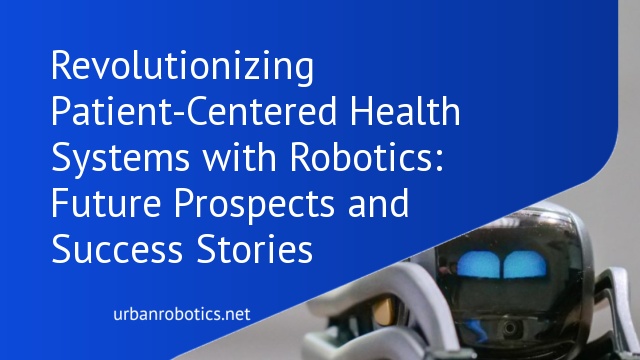Understanding Patient-centered Health Systems
Patient-centered health systems prioritize the needs and preferences of patients in every aspect of care. They ensure patients actively participate in their healthcare decisions. These systems emphasize holistic care by integrating elements like emotional support, patient education, and coordinated care.
Robotics plays a crucial role in enhancing patient-centered care. Surgical robots, for instance, provide precision in procedures, reducing recovery time and pain for patients. Care robots assist in patient monitoring, allowing for continuous and accurate data collection, leading to better personalized treatment plans.
Moreover, robotics can facilitate telemedicine services. Remote-controlled examination robots enable specialists to interact with patients in real-time, bridging geographical barriers and ensuring timely medical intervention. This connectivity improves access to healthcare for patients in underserved areas.
By combining advanced technology with patient-centered principles, we build health systems that are not only efficient but also deeply attuned to individual patient needs. This integration aims to transform patient care through seamless and intelligent solutions, leading to better health outcomes and elevated patient experiences.
Role of Robotics in Healthcare
Robotics is fundamentally reshaping patient-centered health systems by improving precision, efficiency, and personalization in care delivery.
Current Applications in Medicine
Robotics is widely used in various medical fields today. Surgical robots assist in minimally invasive surgeries, reducing recovery times and improving precision. Automated systems handle medication dispensing, reducing errors and optimizing efficiency. Robotic prosthetics provide enhanced mobility for amputees, integrating seamlessly with neurological signals. Additionally, robotic exoskeletons aid in rehabilitation, helping patients regain movement and strength after injuries.
Advances in Robotic Surgery
Robotic surgery offers unparalleled precision and control in medical procedures. Systems like the da Vinci Surgical System enhance a surgeon’s capabilities, enabling complex surgeries through small incisions. These advancements lead to better patient outcomes, including reduced blood loss and quicker recovery. Innovations in soft robotics allow for safer interactions with delicate tissues, expanding the scope of surgical applications. Real-time data integration ensures personalized treatment plans, aligning with patient-centered care principles.
Benefits of Integrating Robotics
Integrating robotics in healthcare carries numerous advantages that significantly align with patient-centered care principles. Below, we explore how robotics enhances patient outcomes and boosts efficiency for healthcare workers.
Improved Patient Outcomes
Robotics in healthcare leads to improved patient outcomes. Surgical robots boost precision and reduce recovery times. Automated medication dispensers minimize errors, ensuring patients receive the correct dosages. Robotic prosthetics and exoskeletons offer enhanced mobility and faster rehabilitation. Real-time data integration with robotic systems enables personalized treatments, increasing the effectiveness of care plans.
Enhanced Efficiency for Healthcare Workers
Robotics enhances efficiency for healthcare workers. Automated systems handle repetitive tasks like medication dispensing and inventory management, freeing up staff for patient interaction. Surgical robots assist in complex procedures, reducing the physical strain on surgeons. Robotic cleaning devices maintain sterile environments, lowering infection risks. Ultimately, robotics allows healthcare professionals to focus more on direct patient care, optimizing resource allocation.
Challenges and Considerations
Implementing patient-centered health systems with robotics brings numerous challenges and considerations that we must address.
Ethical Implications
Robotic healthcare systems raise numerous ethical concerns. Privacy issues arise when patient data is integrated with robotic systems. Responsibility becomes ambiguous if errors occur, causing questions about accountability. Additionally, there’s the potential for reduced human interaction, which could impact patient care quality. Addressing these ethical considerations ensures a balanced and humane implementation of robotics in healthcare.
Economic Factors
Economic factors significantly impact the adoption of robotic systems in healthcare. Initial setup costs for robotic systems are often high, which can strain budgets. Maintenance and training also contribute to the total cost. However, improved efficiency and better patient outcomes can offset these expenses over time. Evaluating the long-term economic impact is essential for sustainable integration.
Case Studies
Numerous healthcare facilities have embraced robotics, creating patient-centered health systems that show remarkable improvements in outcomes. We’ll explore specific examples of success and insights gained from these implementations.
Successful Implementations
Johns Hopkins Hospital: Their robotic prostatectomy program has achieved a 97% success rate with minimal complications. Patients report faster recovery and fewer post-surgery infections.
Mayo Clinic: Utilizing robotic-assisted surgery for heart procedures, the clinic enhanced precision and reduced operation time by 30%. Patients experienced shorter hospital stays and quicker returns to daily activities.
Lessons Learned
Integration of robotics in healthcare must address staff training comprehensively. Johns Hopkins observed that continuous training programs were essential to maintaining high success rates.
Patient feedback revealed that transparency regarding robotic procedures, including potential risks and benefits, significantly improved patient trust and satisfaction. Ensuring informed consent proved crucial for technology acceptance.
Future Prospects
Robotics in healthcare continues evolving, promising more advancements. Let’s explore emerging technologies and their potential impact on health systems.
Emerging Technologies
New technologies in robotics, like AI-driven diagnostics, nanorobots for drug delivery, and autonomous robotic surgery, are transforming patient care. AI-driven diagnostics analyze patient data to identify conditions rapidly. Nanorobots deliver drugs precisely, targeting affected areas effectively. Autonomous robotic surgery offers enhanced precision without human intervention, potentially reducing surgical risks and recovery times.
Potential Impact on Health Systems
Robotic solutions offer significant impacts on health systems. Improved efficiency results from automation, enabling healthcare professionals to focus on patient care, thus reducing operational costs. Enhanced accuracy in diagnostics and treatments leads to better patient outcomes and reduced hospital stays. These innovations could minimize human error, promote preventive care, and streamline administrative tasks, ultimately fostering a more effective patient-centered approach.
Conclusion
Embracing robotics in patient-centered health systems is more than just an innovation; it’s a transformation. By integrating advanced technologies like AI-driven diagnostics and nanorobots, we can achieve unparalleled precision and efficiency in patient care. While challenges such as ethical concerns and high costs remain, the benefits far outweigh the drawbacks.
Case studies from leading healthcare facilities underscore the importance of proper training and clear communication to build trust in robotic procedures. As we continue to adopt these technologies, our focus must remain on enhancing patient outcomes and making healthcare more efficient and personalized.
The future of healthcare is undeniably intertwined with robotics, promising a new era of medical excellence.





